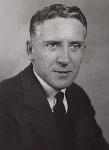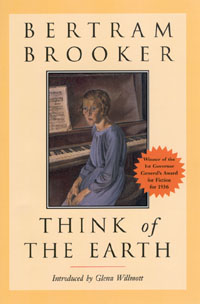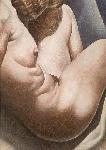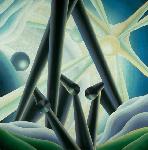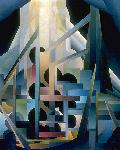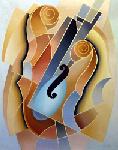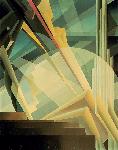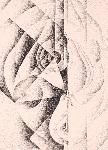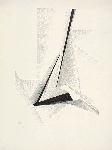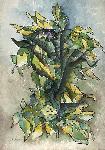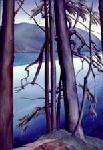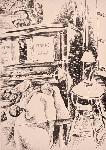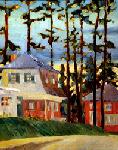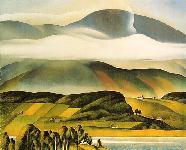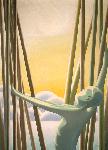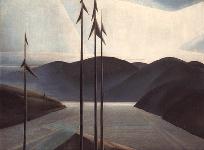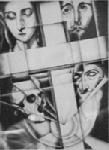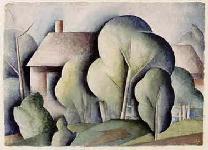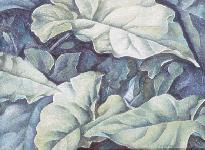| Bertram Brooker
The Art History Archive - Canadian Art
Bertram Brooker: Writer, painter, musician
Born in Croydon, England, March 31st 1888.
Born in Croydon, England, he came with his parents to Portage la Prairie in 1905. He later moved to Toronto in 1921. He acquired a reputation as a writer, painter, musician, and poet. Brooker was a charter member of the Canadian Group of Painters, and he won the Governor General's Award for fiction in 1936 for "Think of the Earth".
Bertram Brooker is an artist of several mediums and is a key example of liberation and innovation in the extensive history of Canadian art. Through a diversity of artistic interpretations and styles, Brooker captures both spiritual and commercial perspectives. He preferred realism during the late '20s and early '30s. It was during this time that he was influenced by LeMoin FitzGerald, a friend of Brooker's and contemporary artist. The mediums range from pencil to water-colour. Though the sketches are mostly realistic, Brooker still employs abstraction. He drew some tree branches with soft, barely visible lines which would fade out at their tips, while other images were contorted through the manipulation of pencil shadings. Brooker once admitted his intent is to capture the rhythm, the ascention, the upward light seeking and springing in each stem, each leaf, each tendril. His tree sketches implement a sense of sensuality, especially "Willow," done in 1932. As the viewer continues through the gallery, the art becomes noticeably sharper and much more modern in appearance. What is surprising to note is that most of the works were done earlier than his realistic, more conservative pieces. The images are innovative abstractions which also have surrealist and cubist undertones. His cubism is reminiscent of Piccasso while his pen and ink is art deco in style. The images in many of his drawings are layers of forms and faces melded into one another. As he once stated, the purpose of this was to portray the feelings of each character within his work as vividly as possible. In observing his abstractions, it is obvious he has an advertising background. They are quite contemporary and even risky for the conservative era of the 1930s. Many of them possess a spiritual quality, with such religious portrayals as his "Bible Series No.1." These pieces are still fresh and fashionable even in today's art world of graphics and computerization. The brilliant exhibit begins on a conservative note with Brooker's realism, then progresses to his abstract and bold dream-like pieces. The works within the exhibit represent the struggles all artists must encounter at some point. Like many artists, Brooker ventures into different mediums and styles to create the most suitable pieces. His themes range from religion to sensuality, yet all have the central theme of spirituality. His employment of commercialism within his abstraction is an interesting contrast. He also successfully keeps his spirituality in all his pieces, while through his advertising background he creates innovative detailed pieces which catch and hold the viewer's eye. Because his art exemplifies his struggles and successes in combining art and business, Bertram Booker is someone with whom most artists should be able to relate. Although Bertram Brooker wasn't as well known as some great artists, like Emily Carr, he was just as good. At the age of 17, he worked in the kitchens and in the time keepers office of the Grand Trunk Pacific Railway. He then managed a movie theatre in Neepawa and also did some newspaper work in Portage and Winnipeg. In 1921, he moved to Toronto and became a freelance journalist and got into advertising. In 1923, Brooker joined the Arts and Letters Club, where he met Lawren Harris and other members from "The Group of Seven". He admired them for "Liberating young artists from the stuffy tradition of strict realism". In 1927, Bertram Brooker became the first artist in Canada to exhibit abstract art. Brooker often talked to Harris about the spirituality of Art and was inspired by the writings of Russian Artist Wassily Kandinsky, whose book, "Concerning the Spiritual in Art" proposed music as a model for the artist seeking to express his inner soul. Bertram Brookers' style of art was mainly abstract but he did realistic works too. For medium, he used oil, water color, pencil, ink, and print. When he would draw abstract, he would paint his experiences derived from music. He'd replicate color, volume, and rhythm into his artwork to create color, interprations of music and sound, with lines circling across the page and jumping out at you. Some of his better known wors of abstract are "Sounds Assembling" (Oil on canvas, 112.3 cm x 91.7 cm) and "Alleluiah" (Oil on canvas) Both of these paintings were derived from listening to music. He had a very successful career in advertising, writing three books about advertising that some speculate might have influenced Marshall McLuhan. He also wrote such books as "Think of the Earth"(1936), "Tangled Miracle"(1936) and "The Robber"(1949). "Think of the Earth" won the prestigious Governor General's award. Set in the west, Think of the Earth explores the metaphysical quandary of Tavistock, the main character: Is it possible to commit a perfectly innocent murder? Yet despite the award, the novel was never reprinted until much later and became a rare book, obtainable only through archival copies. Perhaps the book was ahead of its time. It has persisted as an underground classic in the unique tradition of Canadian modernism. His paintings today hang in every major gallery in Canada. Owing to the public presence of his writing, his opinion reached great distances and held a significant amount of influence. Believing that beauty and truth were related to God and thus only attainable though ecstatic visions of mystics, Brooker condemned useful art and proclaimed that artists would only be able to create with validity when they learned how to expand their sight. In his paintings Brooker worked to escape the chains of both the past and the present and thus avoid reproduction but instead felt he was able to make the truth tangible. He did not believe that expression needed to rely on the world as we know it. From 1928 to 1930 Brooker wrote a syndicated column "The Seven Arts" where he analyzed theatre, music, visual arts and poetry through reviews that underlined the qualities of a distinctly Canadian arts and culture. The writing of this column helped the Group of Seven and their associates become known but over the years Brooker became increasingly disenchanted with the Group's narrow view of a nationally based aesthetics. He wrote to L.L. Fitzgerald: "The experimentation is over, the old aggressiveness has declined. The Group of Seven has become orthodoxy and now, I suppose, the public will start buying their pictures." Brooker's own paintings were unlike anything else being produced in Canada at that time. "Leaf Sonata", "Wings and Waves", and "Abstract Nude" all have a sense of Futurism influence but ultimately Brooker was working with something that was intensely personal and very much a product of his own concerns for art in a civilization which he believed so needed it. Bertram Brooker was also a poet, and the book "Sounds Assembling: The Poetry of Bertram Brooker" shows but a small part of his skill with words. Birk Spaxton has done a wonderful job collecting and organizing the poems in this volume, most of which had not been previously published. (They were originally writen in the late '20s and early '30s.) The poems are beautiful and powerful. It would not be far off to say that his poems were really abstract paintings in ink on paper. (Just as one could probably say his paintings were poems on canvas.) Some more so than others; for instance, "The Ice Man" can be very confusing until one realizes that it is an abstract painting, that all the lines create a picture in motion, a series of verbs. Scandalous! It was 1931 in Toronto the Good, and a painting by Bertram Brooker was removed from the annual OSA exhibition by officers of the Art Gallery of Toronto. Nudes. Bertram Brooker had sent off a painting of nudes for exhibit—two nudes in one painting. Toronto quivered, shuddered, took it down. Small surprise Brooker wrote the now famous essay "Nudes and Prudes". [Right] Bertram Brooker - Torso - 1937.
|
|
||||||
| |||||||
